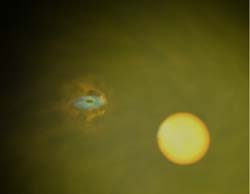ESA’s Integral discovers hidden black holes

An artist’s impression of the mechanisms in an interacting binary system. The supermassive companion star (on the right-hand side) ejects a lot of gas in the form of ’stellar wind’. The compact black hole orbits the star and, due to its strong gravitational attraction, collects a lot of the gas. Some of it is funnelled and accelerated into a hot disc. This releases a large amount of energy in all spectral bands, from gamma rays through to visible and infrared. However, the remaining gas surrounding the black hole forms a thick cloud which blocks most of the radiation. Only the very energetic gamma rays can escape and be detected by Integral.
Integral, ESA’s powerful gamma-ray space telescope, has discovered what seems to be a new class of astronomical objects.
These are binary systems, probably including a black hole or a neutron star, embedded in a thick cocoon of cold gas. They have remained invisible so far to all other telescopes. Integral was launched one year ago to study the most energetic phenomena in the universe.
Integral detected the first of these objects, called IGRJ16318-4848, on 29 January 2003. Although astronomers did not know its distance, they were sure it was in our Galaxy. Also, after some analysis, researchers concluded that the new object could be a binary system comprising a compact object, such as a neutron star or a black hole, and a very massive companion star.
When gas from the companion star is accelerated and swallowed by the more compact object, energy is released at all wavelengths, from the gamma rays through to visible and infrared light. About 300 binary systems like those are known to exist in our galactic neighbourhood and IGRJ16318-4848 could simply have been one more. But something did not fit: why this particular object had not been discovered so far?
Astronomers, who have been observing the object regularly, guess that it had remained invisible because there must be a very thick shell of obscuring material surrounding it. If that was the case, only the most energetic radiation from the object could get through the shell; less-energetic radiation would be blocked. That could explain why space telescopes that are sensitive only to low-energy radiation had overlooked the object, while Integral, specialised in detecting very energetic emissions, did see it.
To test their theory, astronomers turned to ESA’s XMM-Newton space observatory, which observes the sky in the X-ray wavelengths. As well as being sensitive to high-energy radiation, XMM-Newton is also able to check for the presence of obscuring material. Indeed, XMM-Newton detected this object last February, as well as the existence of a dense ’cocoon’ of cold gas with a diameter of similar size to that of the Earth’s orbit around the Sun.
This obscuring material forming the cocoon is probably ’stellar wind’, namely gas ejected by the supermassive companion star. Astronomers think that this gas may be accreted by the compact black hole, forming a dense shell around it. This obscuring cloud traps most of the energy produced inside it.
The main author of these results, Roland Walter of the Integral Science Data Centre, Switzerland, explained: “Only photons with the highest energies [above 10 keV] could escape from that cocoon. IGR J16318-4848 has therefore not been detected by surveys performed at lower energies, nor by previous gamma-ray missions that were much less sensitive than Integral.”
The question now is to find out how many of these objects lurk in the Galaxy. XMM-Newton and Integral together are the perfect tools to do the job. They have already discovered two more new sources embedded in obscuring material. Future observations are planned.
Christoph Winkler, ESA Project Scientist for Integral, said: “These early examples of using two complementary ESA high-energy missions, Integral and XMM-Newton, shows the potential for future discoveries in high-energy astrophysics.”
Media Contact
More Information:
http://www.esa.int/export/esaCP/SEMPHV1P4HD_index_0.htmlAll latest news from the category: Physics and Astronomy
This area deals with the fundamental laws and building blocks of nature and how they interact, the properties and the behavior of matter, and research into space and time and their structures.
innovations-report provides in-depth reports and articles on subjects such as astrophysics, laser technologies, nuclear, quantum, particle and solid-state physics, nanotechnologies, planetary research and findings (Mars, Venus) and developments related to the Hubble Telescope.
Newest articles

First-of-its-kind study uses remote sensing to monitor plastic debris in rivers and lakes
Remote sensing creates a cost-effective solution to monitoring plastic pollution. A first-of-its-kind study from researchers at the University of Minnesota Twin Cities shows how remote sensing can help monitor and…

Laser-based artificial neuron mimics nerve cell functions at lightning speed
With a processing speed a billion times faster than nature, chip-based laser neuron could help advance AI tasks such as pattern recognition and sequence prediction. Researchers have developed a laser-based…

Optimising the processing of plastic waste
Just one look in the yellow bin reveals a colourful jumble of different types of plastic. However, the purer and more uniform plastic waste is, the easier it is to…


